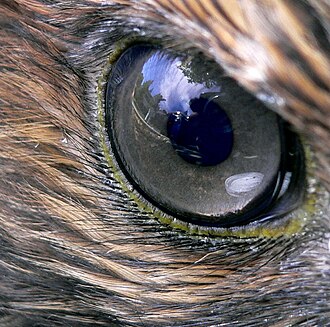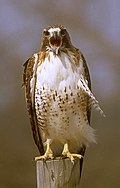Field Guide/Birds/Buteo jamaicensis
The Red-tailed Hawk (Buteo jamaicensis) is a large Buteo which breeds from western Alaska and northern Canada to Panama and the West Indies. Males are typically smaller than females, generally weighing between 800–1100 grams and measuring 45–56 cm in length. Females typically average between 1100–1300 grams and measure 50–65 cm in length.
This is one of three species colloquially known in the United States as the Chickenhawk. It is the most common North American hawk and the raptor most frequently taken from the wild (and later returned to the wild) for falconry in the United States.
Description
Birds of this species have a dark mark along the leading edge of the underwing, between the body and the wrist (the patagium). Most but not all color variations have a dark band across the belly. In most, the adults' tails are rusty red above, and juveniles have narrow brown and pale bands. The main western North American population has bands on the adults' rusty tails as well and has varied plumage, organized into three main color types or morphs.
Immature birds, or birds that are only a few years old, can also readily be identified by having yellowish irises. As the bird attains full maturity over the course of 3–4 years, the iris slowly darken into a reddish-brown hue.
- Light-morph birds are mainly brown on the upperparts and very pale brown or buff on the underparts and underwings; they show a belly band.
- Rufous-morph birds are darker and redder, with reddish-brown rather than white on the underparts. The belly band may be barely visible.
- Dark-morph birds are very dark brown on both upperparts and underparts; they have lighter parts on the underwings.
Almost all of the main eastern North American population are light-morph, with whiter underparts and paler markings than western birds and with solid rust-red tails as adults.
Other variations are:
- Harlan's Hawk usually has blackish plumage contrasting with white undersides of the flight feathers; the tail may be reddish or grey and is longitudinally streaked rather than barred. It breeds in Alaska and northwestern Canada and winters from Nebraska and Iowa to Texas and northern Louisiana. It is sometimes considered a separate species, Buteo harlani.
- Krider's Hawk is paler than other red-tails, especially on the head; the tail may be pinkish or white. It is mainly found in the central prairies of the United States.
Resident breeding birds in Central America have cinnamon underparts which enables them to be easily distinguished from the paler-breasted wintering migrants (Stiles & Skutch).
Behavior
The breeding habitat is open country with high perches. They build a stick nest in a large tree, in a cactus, or on a cliff ledge 35 m or higher above ground; they may also nest on man-made structures. Both sexes build the sturdy nest, made of different sized twigs and sticks, lined with fresh green foliage and evergreen sprigs. The fresh sprigs are regularly replaced during incubation. Up to four eggs may be laid at daily intervals. The shells are colored a dull or bluish-white with a granulated or smooth surface, never glossy. There may be some splotches of various shades of brown. Incubation is by the female from 28 to 35 days, during which time she is fed by the male. The young are able to fly at about 45 days.
In most of the United States, Red-tailed Hawks are permanent residents, but northern breeding birds migrate south in winter. Throughout their range in the U.S., Red-tailed Hawks receive special legal protections under the Migratory Bird Treaty Act of 1918. They have a complex relationship with humans, capable of both controlling rodent and other mammalian pests, and of on occasion being one, taking valuable fowl (which has led to them being one of the species described as a Chickenhawk).
Red-tailed Hawks prefer to wait on a high perch and swoop down on prey; they also patrol open areas in flight. They mainly eat small mammals, birds and reptiles. Their favorite prey varies with regional and seasonal availability but includes most types of rodents, rabbits, pheasant, grouse, quail, rattle snakes, copperheads, lizards, and, when near the water's edge, carp and catfish. Those that live in cities may prefer pigeons and starlings, both of which are plentiful in many urban areas.
In flight, these hawks soar with wings in a slight dihedral, flapping as little as possible. They sometimes hover on beating wings and sometimes "kite", or remain stationary above the ground by soaring into the wind. When soaring or flapping their wings, they typically travel from 30 km/h to 65 km/h but when diving, they reach speeds as high as 195 km/h.
The Red-tailed Hawk is common and widespread, partly because it has benefited from the historic settlement patterns across North America. The clearing of trees in the east of North America provided hunting areas, and the practice of sparing woodlots left nest sites. Conversely, the planting of trees in the west provided nest sites where there had been none. The construction of highways with treeless medians and shoulders and with utility poles alongside provided perfect habitat for perch-hunting, so Red-tailed Hawks are now a common sight along highways. Finally, these birds have moved into New York and other U.S. cities, as in the successful non-fiction book Red-Tails in Love: A Wildlife Drama in Central Park, by Marie Winn. Winn wrote about one of the most famous of them, Pale Male.
Use in falconry
The Red-tailed Hawk is a popular bird in falconry, particularly in America where the sport of falconry is highly regulated at the federal and state levels. According to the United States Fish and Wildlife Service, approximately 60% of all raptors taken from the wild (specifically birds under 1 year of age which are not breeding adults) for use in American falconry are Red-tailed Hawks. The second most popular raptor taken from the wild for falconry is the American Kestrel. The mortality rate for juvenile Red-tailed Hawks in the wild is over 65%, whereas the mortality rate for juvenile Red-tailed Hawks flown by falconers is under 5%. Most falconers eventually release their wild-caught raptors back into the wild once they are of breeding age, and this likely has a positive effect on the species used by falconers.
However, there are so few falconers in the United States (estimated at less than 4,000) that any contribution to the Red-tailed Hawk population, estimated to be approximately one million in the United States, would be statistically insignificant.
The Red-tailed Hawk is a powerful and sturdy falconry bird best flown at larger ground quarry such as squirrels, rabbits, and jackrabbits--though small males are generally not flown at squirrels because squirrel bites can cause serious or permanent damage to a male's smaller feet and toes.
The most common hunting technique with Red-tailed Hawks is to turn the bird loose and let it perch in a tree or other high vantage point. The falconer (sometimes aided by a dog if the bird accepts dogs as hunting partners), then attempts to get a prey animal to move by stirring up ground cover, tapping tree trunks, and shaking vines which to get squirrels to move. The well-trained Red-tailed Hawk will follow the falconer and dog, realizing that their activities produce opportunities to catch game. Contrary to popular belief, once a raptor catches game, it does not bring it back to the falconer. Instead, the falconer must locate the bird, make in, and trade the bird off of its kill in exchange for a piece of ready-to-eat meat--generally from a previous kill.
Winged quarry is normally the domain of the accipiter (such as the Goshawk, Cooper's Hawk, or Sharp-shinned Hawk) or falcon; however, some Red-tailed Hawks can take the occasional pigeon, crow, duck, and even Prairie Chicken. The key to catching these unusual winged quarry often lies in building the bird's confidence that it can catch this game and cooperative hunting techniques where the falconer positions the bird for a fast and stealthy approach while flushing the game to maximize the red-tailed hawk's chances of success.
Behaviorally, the Red-tailed Hawk is generally a very easy-going bird in captivity and an eager and willing hunting partner once in the field. They will however revert to a semi-wild state in 1-3 weeks without training or hunting, which makes it very easy to fatten them up and almost effortlessly return them to the wild once the hunting season is over and just prior to the breeding season.
Feathers and native American use
- The feathers and other parts of the Red-tailed Hawk are considered sacred to many American indigenous people and, like the feathers of the Bald Eagle and Golden Eagle, are sometimes used in religious ceremonies and found adorning the regalia of many Native Americans in the United States; these parts, most especially their distinctive tail feathers, are a popular item in the Native American community. As with the other two species, the feathers and parts of the Red-tailed Hawk are regulated by the eagle feather law (Title 50 Part 22 Code of US Federal Regulations), which governs the possession of feathers and parts of migratory birds.
Trivia
- A certain recording of the cry of the Red-tailed Hawk is probably one of the most often heard cinematic sound clichés. This high, fierce scream is often featured in the background of adventure movies to give a sense of wilderness to the scene. However, the cry is more commonly used for the Bald Eagle.
- In literature, one popular portrayal of a Red-tailed Hawk is in the book series Animorphs. In this series, the Red-tailed Hawk is the morph that the character Tobias becomes trapped in.
Gallery
- Redtailedhawkap.jpg
Juvenile eastern race
References
- Template:IUCN2006 Database entry includes justification for why this species is of least concern
- Stiles and Skutch, A guide to the birds of Costa Rica ISBN 0-8014-9600-4
- Electronic Code of Federal Regulations (e-CFR), Title 50: Wildlife and Fisheries PART 22—EAGLE PERMITS[1]
- Migratory Bird Treaty Act of 1918
- Mullinex, Matthew. (2002). American Kestrels in Modern Falconry. Western Sporting Publications. ISBN 1-888357-05-3.
- McGranaghan, Liam J. (2001). The Red-Tailed Hawk: A Complete Guide to Training and Hunting North America's Most Versatile Game Hawk. ISBN 0-9709571-0-6.
External links
- Cornell University Ornithology Lab page about the Red-tailed Hawk, including samples of their cry
- USGS web page about the Red-tailed Hawk
- Red-Tailed Hawks Pictures
- Religious Freedom with Raptors
- North American Falconers Association
- Comparison of Adult & Immature tails
fr:Buse à queue rousse it:Buteo jamaicensis nl:Roodstaartbuizerd ja:アカオノスリ pt:Búteo-de-cauda-vermelha fi:Amerikanhiirihaukka





